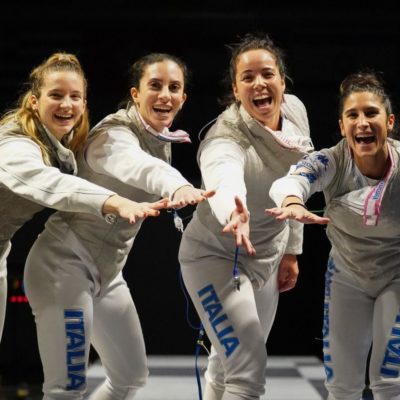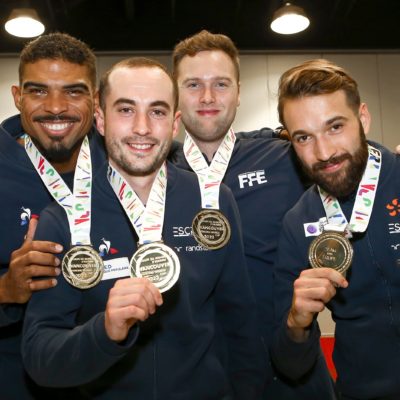 |
| Keeth Smart led the 2008 Men’s Sabre team. |
Converting Disappointments into Success, then Grief into Olympic Glory: Keeth Smart’s Olympic Journey
Keeth Smart anchored the US men’s saber team in the 2008 Beijing Summer Olympics and earlier in his career was the first American fencer to be ranked number one in the world.
He has led the charge to bring men’s saber fencing out of the shadows and into the limelight of well-known and respected Olympic sports. His life is epitomized by overcoming obstacles.
Keeth led the typical life of a kid his age in Brooklyn, bikeriding and playing baseball and basketball nearly year round. Through their dad’s job at Sports Illustrated, Keeth and his sister were able score tickets to some of the best athletic events in town. “We definitely were exposed to a lot of different first-class sporting events. At the same time, both of our parents were extremely athletic and became role models. They really helped us become athletes.”
{sidebar id=1} At age 11, Keeth and his sister were introduced to the sport of fencing through an article in SI; he started fencing under the renowned Olympian Peter Westbrook, who had begun a foundation dedicated to teaching fencing as a way to help inner-city kids develop both athletically and academically. Keeth began by fencing foil, which teaches the fundamentals of attack and defense, but quickly found its strategy, rules and small target area too restrictive to be enjoyed. When he changed weapons and moved into saber, however, he knew he had discovered something worth pursuing.
“I always wanted to be a competitive fencer because I saw the top fencers from day one at the Peter Westbrook Foundation. These guys were training for the Barcelona and Atlanta Olympic games, so in order to pursue my dreams I would ask to fence them, even though I was still young and inexperienced.”
There were points along the way, particularly in high school, when the Olympic dream felt unattainable. While many of his fencing companions were making national teams and competing internationally for the US, Keeth was unable to qualify.
“It was frustrating, discouraging; all my teammates were having very successful careers. I had to stay home while they went to Europe to compete. My parents kept me motivated; they really believed in me. They said, ‘You’ve always been a late bloomer, you will make it with this, too.’ That’s what motivated me to dig in my heels and try even harder.”
Keeth was humbled during this period of his life, training harder than most of his teammates, without translating that into competition success. This ended up helping in the long run:
“It kept everything in perspective. I learned that even though things may not turn out how you want, it’s not the end of the world.”
In addition, his mother did her best to instill within her son an appreciation for God’s sovereignty, even in difficult times. “She put a lot of faith in me to see that God would make sure everything worked out well. Everything happens for a reason. That’s something she emphasized from the beginning, and for the most part it’s been true for me.”
At the end of his high-school senior year, St. John’s University recruited Keeth on a full athletic scholarship. While there, he qualified for the US national team and twice won the NCAA men’s saber competition.
In 2000, after having trained for ten years, Keeth made his Olympic debut at the Sydney games. The team did not medal that year, but he considered it well worth the experience just to participate. He took the next year off from fencing, then picked up his saber again in time to become the first US fencer to ever attain a first-place points ranking internationally after wining second place at the 2003 World Cup.
In 2004, the US men’s saber team went to Athens hoping to do something that no male US fencer had done for 20 years: win a medal. But the lofty dreams came crashing down as Keeth’s semi-final bout fell short of victory by just one point; as a result, he found himself the object of scorn and criticism in some American fencing circles. The US team had been ahead by five points when he got up to fence, but by the end of the bout that lead had eroded to a tie, broken by a final touch from the Russian Federation’s anchor, Stanislav Pozdniakov, who holds more Olympic and World Cup titles than any other active saber fencer in the world.
Keeth took the defeat to heart and gave up fencing for the next year and a half. His mother helped him cope with the difficult loss and put everything into perspective. “I spoke to her every single day after that setback in Athens when everyone in US fencing was disappointed with how I blew the lead. She reminded me, ‘It’s okay, everything happens for a reason, you just have to stay positive.’”
The year after losing his chance for an Olympic medal, Keeth lost one of the biggest inspirations for pursuing the sport in the first place: his father died of a heart attack. Things went from bad to worse; soon afterward, his mother was diagnosed with colon cancer.
Keeth chose to move forward with his fencing career in 2006 and once again made the national team. He pushed forward with his Olympic goal and hoped to slay past regrets. But on the day he discovered his guaranteed spot on the Olympic team, four months before Beijing, Keeth had to check into a hospital. He had been exhibiting strange symptoms and was told by doctors that he had contracted a rare blood disease called Immune Thrombocytopenic Purpura (ITP), most likely from food he had eaten while competing in Algeria.
“The first prognosis was, ‘Forget fencing, you might not live beyond this hospital visit.’ My whole world went upside down, because I had been in perfect health, preparing my body for the Olympics. Then, all the sudden, I was in intensive care for two weeks.”
The doctors put him in a protective bubble room and were extremely cautious around him because, they explained, if he had done something as benign as stub his toe, he would have bled to death.
Keeth was a model patient. Because he was already in such superb condition due to his training, doctors were able to adjust medicine dosages to improve the healing process in ways otherwise impossible were he just an average patient. He did so well that the hospital wrote a case study about him.
Trying to train for the Olympics while recovering from his disease became a daunting task. He was so weak that his first training sessions had to be against small children. “While my Olympic teammates were fine-tuning their technique, I had lost my motor skills and had to relearn basic fencing moves. All my friends were going to Europe to compete, and I had to stay home. It was like I was fifteen again.”
With three months before Beijing, his final column of support was knocked out from under him. His mother, who had inspired and encouraged him through years of fruitless training and discouraging results, lost her battle with stage IV colon cancer, having already renewed her passport so she could watch him in Beijing. Though he was devastated by the loss, her years of wise words were not lost on him.
Fast-forward to Beijing. Keeth’s sister Erinn wins a silver in women’s team foil. The next day, he is the one with sword in hand, once again anchoring the US team, carrying it back from the brink of despair by a courageous come-from-behind win against Hungary. Then, déjà vu. The US team is tied with Russia. The last bout. Keeth Smart is once again facing Pozdniakov with only one point to determine which team would win the medal.
This time Keeth scored the final touch.
The US men’s saber team took home a silver medal from Beijing, the best finish in American history. Keeth announced his retirement from the sport immediately after the games, but he can still be seen on Saturdays, helping young children at the Peter Westbrook Foundation, teaching them the fundamentals of fencing and about never letting go of their dreams.
1978: Born in Brooklyn, NY
1997-99: Fences competitively in college and wins two NCAA titles
2000: Fences in his first Olympics in Sydney
2003: Becomes the first fencer in American history to be ranked in first place internationally
2004: Competes in the Athens Olympics and misses the medal by one point
2005-2006: Father dies unexpectedly of a heart attack; qualifies for the national team for the second time
2008: Diagnosed with Immune Thrombocytopenic Purpura and mother loses her fight with colon cancer
August 2008: Leads the US team to a silver medal, its best-ever Olympic finish





